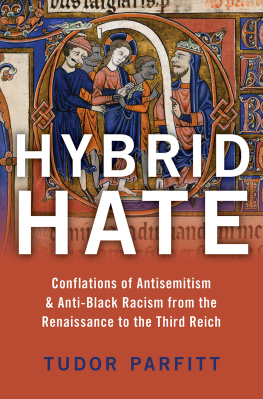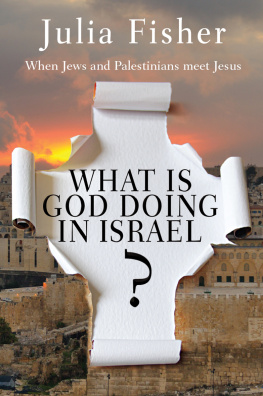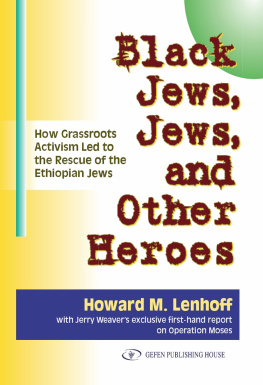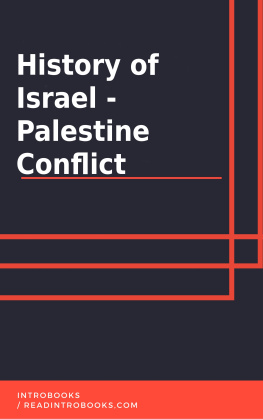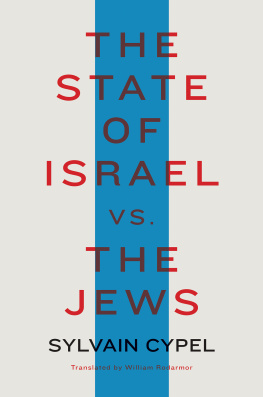The Beta Israel in Ethiopia and Israel
The Beta Israel in Ethiopia and Israel
Studies on Ethiopian Jews
Edited by
Tudor Parfitt
and
Emanuela Trevisan Semi
First Published in 1999 by Curzon Press
Published 2013
by Routledge
2 Park Square, Milton Park, Abingdon, Oxon OX14 4RN
711 Third Avenue, New York, NY, 10017, USA
Routledge is an imprint of the Taylor & Francis Group, an informa business
1999 Tudor Parfitt and Emanuela Trevisan Semi
All rights reserved. No part of this book may be reprinted or reproduced or utilised in any form or by any electronic, mechanical, or other means, now known or hereafter invented, including photocopying and recording, or in any information storage or retrieval system, without permission in writing from the publishers.
British Library Cataloguing in Publication Data
A catalogue record of this book is available from the British Library
Library of Congress Cataloguing in Publication Data
A catalogue record for this book has been requested
ISBN 13: 978-0-700-71092-8 (hbk)
Contents
| Tudor Parfitt |
| Emanuela Trevisan Semi |
| Shalva Weil |
| Daniel Summerfield |
| Simon D. Messing |
| Daniel Friedmann |
| Richard Pankhurst |
| Don Seeman |
| Steven Kaplan |
| Eva Leitman and Elisabeth Weinbaum |
| Jennifer Phillips Davids |
| Kirsten Holert |
| Malka Shabtay |
| Marilyn Herman |
| Dawn Lille Honwitz |
| Lisa Anteby |
| Margaret Hayon |
| F.Alvarez-Pereyre and S. Ben-Dor |
| Simha Arom and Olivier Tourny |
| Anhessa Tefarra |
| Anita Nudelman |
| Marian Reiff |
| R. Youngmann, S. Minuchin-ltzigsohn, and M. Zere |
| Beniamin Mekuria |
| Itzhak Grinfeid |
Note
This volume is muti-disciplinary in nature ana draws on the work both of young researchers and well-established scholars. In view particularly of the multi-disciplinary charactcr of the book the editors decided not to attempt to impose a standard system of transliteration: each contributor was free to use the system best suited to his or her own purpose. The only exception to this is in the case of commonly used words or expressions where a standard, nontechnical, form has been adopted.
The editors would like to acknowledge the generosity of the Israeli Ministry of Absorption, the American Joint Distribution Committee, Israel, the Jewish Agency, the Israeli Ministry of Foreign Affairs, the Israeli Ministry of Science and Technology and the Israeli Academy of Sciences. The editors are most grateful to Dr. David Appleyard for his assistance. The editors are particularly grateful to the officers and members of the Society for the Study of Ethiopian Jewry (SOSTEJE) at whose conference in Jerusalem and Beersheva in 1995 these papers were first presented and acknowledge the immense efforts made by Professor Steve Kaplan and many Israeli colleagues as well as the staff of the Ben Zvi Institute, Jerusalem and the University of Beersheva. Without their help this volume would not have seen the light of day. Most of all however the editors would like to thank Diana Gur and the staff of the Centre of Near and Middle East Studies at the School of Oriental and African Studies, University of London, for all the work they have put into the preparation of this volume.
This volume presents the latest research on various aspects of the complex life of the Jews of Ethiopia. Even the nomenclature of this small tribe is attended by complications: traditionally referred to in western literature as Falashas the Ethiopian Jews today eschew this term and prefer another traditional term Beta Israel. While usually referred to in Israel as 'Ethiopians' or 'Jews from Ethiopia' they themselves aspire to be Israelis although Israelis with certain cultural antecedents. The evolution from an Ethiopian tribe to a somewhat problematic minority in a modern Middle Eastern state is the topic of this book. It is now understood that this development started in the nineteenth century and continues today. These pages place particular emphasis on the role of Jacques Faitlovitch and the process of Judaisation which he helped to inaugurate, That he was not more successful in the short term can be attributed to the resistance of certain Jewish institutions such as the Alliance Israelite Universelle as well as to the troubled history of the first half of the twentieth century. The first chapter by Tudor Parfitt on Rabbi Nahoum's mission to Ethiopia casts new light on the attitude of the Alliance and how it was affected by the Turkish rabbi's report. The problematic of the Italian occupation and Italian policies vis a vis the Jews has been thoroughly researched by Daniel Summerfield in a ground-breaking study.
One of the methods Faitlovitch used to spread the idea that the Beta Israel formed part of the Jewish people was to send a number of Falasha students to be educated in Europe and Palestine. Emanuela Trevisan Semi and Shalva Weil examine the lives of two of these students which so well symbolise the problems of integration and cross-cultural movement and present us with new and revealing information about this human experiment not untouched by tragic elements. Further insight into the first encounter on the part of the Beta Israel with the modern world is found in the account by Beniamin Mekuria of his father's and uncle's long trek from Gondar to the Faitlovitch school in Adis Ababa in the 1920s. Simon Messing has provided us with two personal letters one from Faitlovitch, the other from Tadesse Yaakov the latter of particular interest because of the light it sheds on the life of Beta Israel converts to Christianity.
The issue of the Beta Israel converts the Falas Mura has been a highly controversial one in Israel over the last years. Now a substantial proportion of the Falas Mura have left for Israel to join the Beta Israel who arrived with Operations Moses and Solomon. Daniel Friedman's chapter looks at this vexed issue in the light of the Law of Return and addresses the more general question of conversion in Judaism. Richard Pankhurst also touches this subject in his chapter which deals with mixed dynastic marriages between the fifteenth and seventeenth centuries. In a contemporary context Don Seeman's chapter analyses the issue of Beta Israel conversion to the Pentecostal movement a trend which occurred in Ethiopia as as well as in Israel. Revealing data are provided which clarify a central question: the relationship between the converts themselves and their Jewish relatives and we learn here and elsewhere that the boundaries between these confessional groups are much less rigid than might have been supposed.
Steve Kaplan has turned to the issue of the Beta Israel's integration in Israel and uses the concept of 'everyday resistance' to explain their strategies of survival. The question of survival and integration this time in the context of army experience is examined by Malka Shabtay in a study drawn from her doctoral work and this military theme is continued in Marilyn Herman's chapter on Ethiopian battle songs which are based on a suitably modified traditional medium but serve contemporary ends. The issue of continuity and change is central to several of our studies: the changing role of Ethiopian disco dance and music in the lives of young Ethiopians in Israel is analysed by Dawn Lille Horwitz and the general absorption of features connected with advanced industrial societies in this case the video is examined by Lisa Antby. In recent years the cultural specificity of the Beta Israel has been questioned in some important studies. Two chapters on the Beta Israel liturgy look at literary and musical structure and conclude that there are indeed features which appear to be sui generis. The question of orality as against written traditions in the liturgy is taken up by Margaret Hayon. Grinfeld presents some original documentation; Tefarra some important observations on dialectal differences between the Amharic of Gondar and Addis Ababa.


